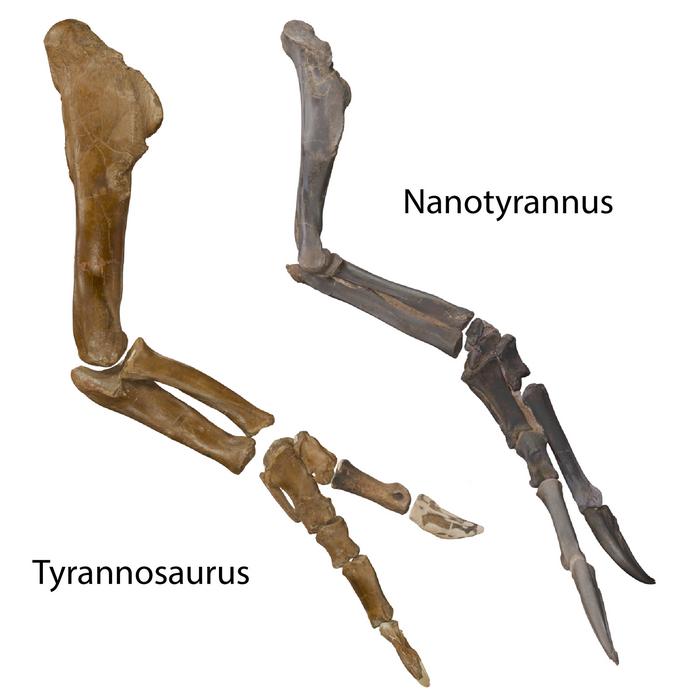Nov 03 2025
Nanotyrannus Controversy Solved
 One of the things I like about following paleontology news is that new evidence can just be discovered, and sometimes these new pieces to the puzzle can significantly change what we think about past life. One such controversy I have been following for a while is whether or not small specimens of Tyrannosaurus rex-like dinosaurs represent juvenile T-rexes or a separate smaller species of theropod dinosaur. A new analysis of a nearly complete Nanotyrannus specimen has definitively resolved the debate – Nanotyrannus was a separate genus.
One of the things I like about following paleontology news is that new evidence can just be discovered, and sometimes these new pieces to the puzzle can significantly change what we think about past life. One such controversy I have been following for a while is whether or not small specimens of Tyrannosaurus rex-like dinosaurs represent juvenile T-rexes or a separate smaller species of theropod dinosaur. A new analysis of a nearly complete Nanotyrannus specimen has definitively resolved the debate – Nanotyrannus was a separate genus.
There are several layers of context that make this story more interesting. First, why was it so difficult to determine if different specimens were the same genus or not? This is not just due to having incomplete specimens – even with complete specimens, this can sometimes be tricky. Will all unknown species paleontologists need to determine if morphological differences are just within-species variation, different growth stages, or even male-female differences. Are we looking at two different species or genera, or a male and female of the same species?
This can be particularly difficult with dinosaurs, because many dinosaur species grow very large over a long period of time. Further, they can undergo significant morphological change as they grow. Another similar controversy, for example, was between Triceratops and Taurasaurus, the latter being larger and with a slightly different frill. It was considered plausible that Taurasaurus specimens were just older Triceratops, and therefore bigger and with age-related changes to the frill. With further specimens and analysis it is now considered that Taurasaurus is its own genus within the family Ceratopsidae.
The latest study is of a near complete Nanotyrannus, and analysis shows some critical features. First, bone growth rings and spinal fusion data show that it was mature and no longer growing at the time of death. That is probably the most important thing – this was a mature dinosaur, not a juvenile. The specimen also demonstrated larger forelimbs, more teeth, fewer tail vertebrae, and distinct skull nerve patterns from T. rex. Of these perhaps the skull nerve patterns are most definitive. These are the holes in the skull through which cranial nerves will exit and they generally will not migrate from a juvenile to adult animal. All this taken together ends the debate, it is now considered practically impossible that Nanotyrannus is the same genus as Tyrannosaurus.
The implications also go beyond this one question, for a couple of reasons. One is that T. rex was an apex predator at the very end of the Cretaceous period, at the end of the age of dinosaurs. T. rex witnessed the impact of the asteroid that caused the end-Cretaceous mass extinction. They are therefore a critical part of our understanding of the ecosystems that existed at the time of this extinction event. How diverse were these ecosystems, and were large non-avian dinosaurs already in decline prior to the impact?
Second, specimens of what we now know to be members of the Nanotyrannus genus were considered part of the T. rex “hypodigm” (a term that refers to all of the specimens that constitute our understanding of the entire growth cycle and populations of a specific species). In other words, our understanding of T. rex was partly based on specimens that we now know were not T. rex. This, therefore, changes our understanding of not just Nanotyrannus, but of T. rex itself.
The paper also has determined that there were at lest two species of Nanotyrannus – N. lancensis and N. lethaeus. This further implies that the family Tyrannosauridae was perhaps far more diverse and widespread than previously understood, which further implies that there were robust and thriving ecosystems of large dinosaurs in the end-Cretaceous.
This story is not complete, of course. More specimens will add new chapters to the story for a long time. Interestingly, this specimen of Nanotyrannus was found together with a specimen of Triceratops – the two caught in a battle that resulted in their mutual demise. This is a classic dinosaur struggle that is actually true. It is also interesting that the smaller Tyrannosauridae species would also pray upon Triceratops, which was a formidable target given its deadly horns. Nanotyrannus was likely a very agile hunter, quicker and more agile than its larger cousins. This implies a different niche, but clearly there was a lot of overlap. We also find these specimens in the same strata, so they co-existed in the same ecosystems.
This is all part of why I find paleontology so fascinating. For different groups of animals we have a widely varying completeness of the “hypodigm” and therefore picture of their evolution. But even for ones where the specimens are numerous and the data fairly robust, one well-preserved specimen can often overturn a lot of previous inferences. This is a fairly exceptional case – requiring an extensive rewriting of what we thought we understood about T. rex.






